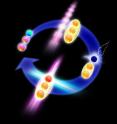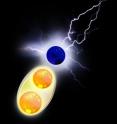The quantum computer is growing up
A general rule in data processing is that disturbances cause the distortion or deletion of information during data storage or transfer. Methods for conventional computers were developed that automatically identify and correct errors: Data are processed several times and if errors occur, the most likely correct option is chosen. As quantum systems are even more sensitive to environmental disturbances than classical systems, a quantum computer requires a highly efficient algorithm for error correction. The research group of Rainer Blatt from the Institute for Experimental Physics of the University of Innsbruck and the Institute for Quantum Optics and Quantum Information of the Austrian Academy of Sciences (IQOQI) has now demonstrated such an algorithm experimentally. "The difficulty arises because quantum information cannot be copied," explains Schindler. "This means that we cannot save information repeatedly and then compare it." Therefore, the physicists use one of the peculiarities of quantum physics and use quantum mechanical entanglement to perform error correction. Quick and efficient error correction
The Innsbruck physicists demonstrate the mechanism by storing three calcium ions in an ion trap. All three particles are used as quantum bits (qubits), where one ion represents the system qubit and the other two ions auxiliary qubits. "First we entangle the system qubit with the other qubits, which transfers the quantum information to all three particles," says Philipp Schindler. "Then a quantum algorithm determines whether an error occurs and if so, which one. Subsequently, the algorithm itself corrects the error." After having made the correction, the auxiliary qubits are reset using a laser beam. "This last point is the new element in our experiment, which enables repetitive error correction," says Rainer Blatt. "Some years ago, American colleagues demonstrated the general functioning of quantum error correction. Our new mechanism allows us to repeatedly and efficiently correct errors."
Leading the field
"For a quantum computer to become reality, we need a quantum processor with many quantum bits," explains Schindler. "Moreover, we need quantum operations that work nearly error-free. The third crucial element is an efficient error correction." For many years Rainer Blatt's research group, which is one of the global leaders in the field, has been working on realizing a quantum computer. Three years ago they presented the first quantum gate with fidelity of more than 99 percent. Now they have realized another key element: repetitive error correction.
Source: University of Innsbruck
Other sources
- The quantum computer is growing up: Repetitive error correction in a quantum processorfrom Science DailyFri, 27 May 2011, 2:30:31 UTC
- The quantum computer is growing up: Repetitive error correction in a quantum processorfrom PhysorgThu, 26 May 2011, 18:30:54 UTC

